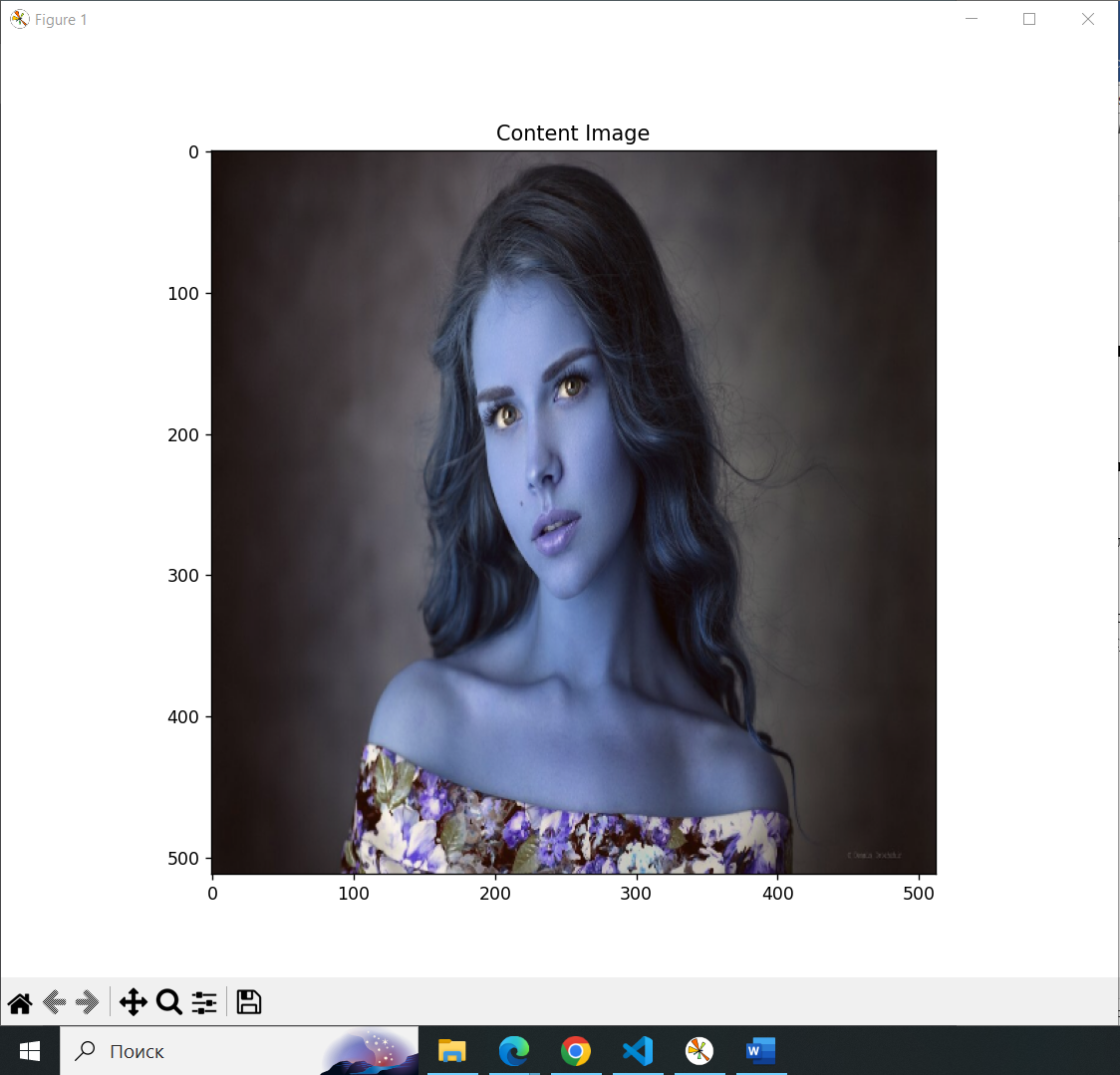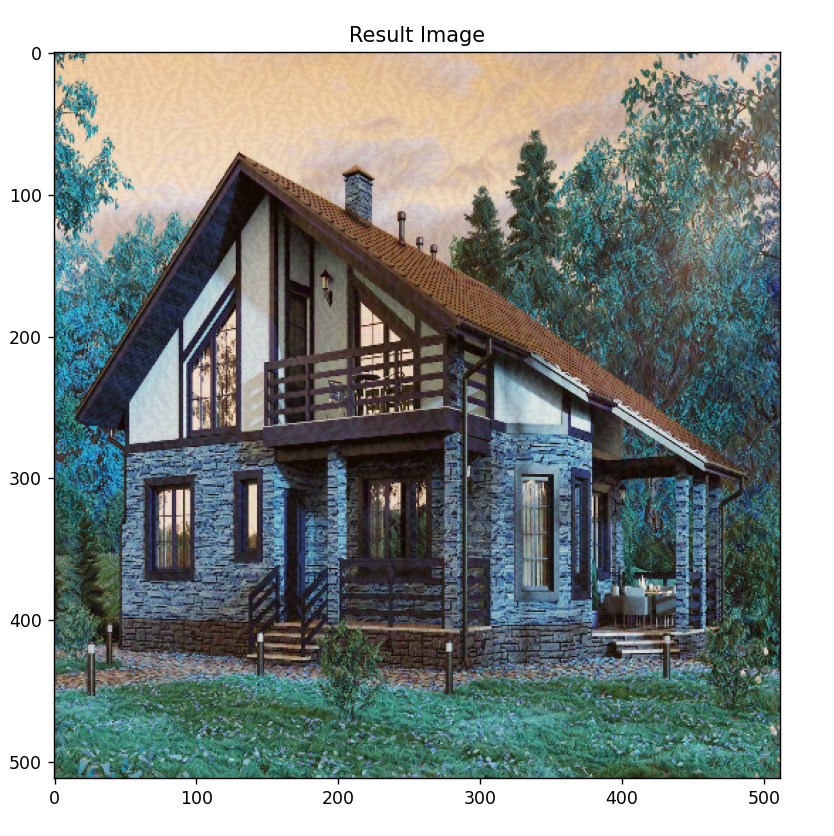
Интеллектуальные информационные системы 4 курс Попов / Кольцова АА ЛР8
.docxМинистерство науки и высшего образования Российской Федерации
Федеральное государственное бюджетное образовательное
учреждение высшего образования
«Сочинский государственный университет»
Кафедра Информационных технологий
ОТЧЁТ
по лабораторной работе № 8
«Перенос стиля изображения»
Выполнила: студентка группы 20-ПИ
Кольцова Адриана Андреевна
Дата: 30.12.2023
Проверил: д.т.н. проф. Попов Д.И.
Дата: _______________
Замечания:
______________________________________________________________________________________________________________________________________________________________________________________________________
Сочи 2023
Решение
Первый вариант кода
Код программы:
import os
import numpy as np
import matplotlib.pyplot as plt
from PIL import Image
import tensorflow as tf
import logging
# Установка параметров отображения графиков
plt.rcParams['figure.figsize'] = (10, 8)
plt.rcParams['axes.grid'] = False
# Подготовка данных
temp_dir = 'temp_images'
os.makedirs(temp_dir, exist_ok=True)
content_path = os.path.join('C:\\Users', 'adriana', 'ss', '4.jpg')
style_path = os.path.join('C:\\Users', 'adriana', 'ss', 'aa.jpg')
# Инициализация и настройка окружения
os.environ['TF_CPP_MIN_LOG_LEVEL'] = '2'
tf.compat.v1.disable_eager_execution()
# Загрузка и отображение изображений
def load_and_preprocess_image(image_path):
img = Image.open(image_path)
img = tf.keras.preprocessing.image.img_to_array(img)
img = tf.image.resize(img, [512, 512])
img = tf.keras.applications.vgg19.preprocess_input(img)
return img[tf.newaxis, :]
content_image = load_and_preprocess_image(content_path)
style_image = load_and_preprocess_image(style_path)
# Отображение исходных изображений
def imshow(image, title=None):
if tf.executing_eagerly():
# В режиме eager execution используйте numpy()
image = tf.keras.preprocessing.image.array_to_img(tf.squeeze(image).numpy())
else:
# В символьном режиме используйте eval() с явным указанием сеанса
sess = tf.compat.v1.keras.backend.get_session()
image = tf.keras.preprocessing.image.array_to_img(tf.squeeze(image).eval(session=sess))
plt.imshow(image)
if title:
plt.title(title)
plt.show()
# И вызывайте функцию imshow следующим образом:
imshow(content_image, 'Content Image')
imshow(style_image, 'Style Image')
# Определение функций для работы с матрицами Грама
def gram_matrix(input_tensor):
result = tf.linalg.einsum('bijc,bijd->bcd', input_tensor, input_tensor)
input_shape = tf.shape(input_tensor)
num_locations = tf.cast(input_shape[1] * input_shape[2], tf.float32)
return result / num_locations
# Получение представлений стиля и содержания из модели
def get_model():
vgg = tf.keras.applications.VGG19(include_top=False, weights='imagenet')
vgg.trainable = False
style_layers = ['block1_conv1', 'block2_conv1', 'block3_conv1', 'block4_conv1', 'block5_conv1']
content_outputs = [vgg.get_layer('block5_conv2').output]
style_outputs = [vgg.get_layer(layer).output for layer in style_layers]
return tf.keras.models.Model(inputs=vgg.input, outputs=content_outputs + style_outputs)
# Вычисление значений потерь контента и стиля
def get_content_loss(base_content, target):
return tf.reduce_mean(tf.square(base_content - target))
def get_style_loss(style, gram_target):
return tf.reduce_mean(tf.square(gram_matrix(style) - gram_target))
# Вычисление общей потери и градиента
def compute_loss(model, base_image, style_targets, content_targets, content_weight, style_weight):
model_outputs = model(base_image)
content_output, style_outputs = model_outputs[0], model_outputs[1:]
content_loss = get_content_loss(content_output, content_targets)
style_loss = 0
for i, style_output in enumerate(style_outputs):
style_loss += get_style_loss(style_output, style_targets[i])
style_loss *= style_weight
total_loss = content_weight * content_loss + style_loss
return total_loss, content_loss, style_loss
# Запуск процесса переноса стиля
def run_style_transfer(content_path, style_path, num_iterations=1000, content_weight=1e3, style_weight=1e-2):
model = get_model()
for layer in model.layers:
layer.trainable = False
content_image = load_and_preprocess_image(content_path)
style_image = load_and_preprocess_image(style_path)
style_targets = [gram_matrix(style_layer) for style_layer in model(style_image)[1:]]
content_targets = model(content_image)[0]
base_image = tf.Variable(content_image)
opt = tf.optimizers.Adam(learning_rate=5, beta_1=0.99, epsilon=1e-1)
best_loss, best_img = float('inf'), None
cfg = {
'model': model,
'base_image': base_image,
'style_targets': style_targets,
'content_targets': content_targets,
'content_weight': content_weight,
'style_weight': style_weight
}
norm_means = np.array([103.939, 116.779, 123.68])
min_vals = np.array([-103.939, -116.779, -123.68])
max_vals = 255 - min_vals
def compute_grads(cfg):
with tf.GradientTape() as tape:
all_loss = compute_loss(**cfg)
total_loss = all_loss[0]
grads = tape.gradient(total_loss, cfg['base_image'])
cfg['base_image'].assign(tf.clip_by_value(cfg['base_image'], min_vals, max_vals))
return grads, all_loss
for i in range(num_iterations):
grads, all_loss = compute_grads(cfg)
loss, content_loss, style_loss = all_loss
opt.apply_gradients([(grads, base_image)])
clipped_base = tf.clip_by_value(base_image, min_vals, max_vals)
base_image.assign(clipped_base)
if loss < best_loss:
best_loss = loss
best_img = base_image.numpy()
if i % 100 == 0:
logging.info(f"Iteration {i}: Total Loss: {loss}, Content Loss: {content_loss}, Style Loss: {style_loss}")
return best_img
# Запуск алгоритма и сохранение итогового изображения
result_image = run_style_transfer(content_path, style_path)
result_path = os.path.join('C:\\Users', 'adriana', 'ss', 'aa11.jpg')
result_image = np.squeeze(result_image, axis=0)
result_image = tf.keras.preprocessing.image.array_to_img(result_image)
result_image.save(result_path)
# Отображение итогового изображения
plt.imshow(result_image)
plt.title('Result Image')
plt.show()
Результат выполнения команд:


Вывод:

Второй вариант кода:
import os
import numpy as np
import matplotlib.pyplot as plt
from PIL import Image
import tensorflow as tf
import logging
# Enable eager execution
tf.config.run_functions_eagerly(True)
# Set display parameters
plt.rcParams['figure.figsize'] = (10, 8)
plt.rcParams['axes.grid'] = False
# Prepare data
temp_dir = 'temp_images'
os.makedirs(temp_dir, exist_ok=True)
content_path = os.path.join('C:\\Users', 'adriana', 'ss', '4.jpg')
style_path = os.path.join('C:\\Users', 'adriana', 'ss', 'aa.jpg')
# Load and display images
def load_and_preprocess_image(image_path):
img = Image.open(image_path)
img = tf.keras.preprocessing.image.img_to_array(img)
img = tf.image.resize(img, [512, 512])
img = tf.keras.applications.vgg19.preprocess_input(img)
return img[tf.newaxis, :]
content_image = load_and_preprocess_image(content_path)
style_image = load_and_preprocess_image(style_path)
# Отображение исходных изображений
def imshow(image, title=None):
if tf.executing_eagerly(): # Изменено на tf.executing_eagerly()
# В режиме eager execution используйте numpy()
image = tf.keras.preprocessing.image.array_to_img(tf.squeeze(image).numpy())
else:
# В символьном режиме используйте eval() с явным указанием сеанса
sess = tf.compat.v1.keras.backend.get_session()
image = tf.keras.preprocessing.image.array_to_img(tf.squeeze(image).eval(session=sess))
plt.imshow(image)
if title:
plt.title(title)
plt.show()
imshow(content_image, 'Content Image')
imshow(style_image, 'Style Image')
# Define functions for working with Gram matrices
def gram_matrix(input_tensor):
result = tf.linalg.einsum('bijc,bijd->bcd', input_tensor, input_tensor)
input_shape = tf.shape(input_tensor)
num_locations = tf.cast(input_shape[1] * input_shape[2], tf.float32)
return result / num_locations
# Get style and content representations from the model
def get_model():
vgg = tf.keras.applications.VGG19(include_top=False, weights='imagenet')
vgg.trainable = False
style_layers = ['block1_conv1', 'block2_conv1', 'block3_conv1', 'block4_conv1', 'block5_conv1']
content_outputs = [vgg.get_layer('block5_conv2').output]
style_outputs = [vgg.get_layer(layer).output for layer in style_layers]
return tf.keras.models.Model(inputs=vgg.input, outputs=content_outputs + style_outputs)
# Calculate content and style losses
def get_content_loss(base_content, target):
return tf.reduce_mean(tf.square(base_content - target))
def get_style_loss(style, gram_target):
return tf.reduce_mean(tf.square(gram_matrix(style) - gram_target))
# Calculate total loss and gradient
def compute_loss(model, base_image, style_targets, content_targets, content_weight, style_weight):
model_outputs = model(base_image)
content_output, style_outputs = model_outputs[0], model_outputs[1:]
content_loss = get_content_loss(content_output, content_targets)
style_loss = 0
for i, style_output in enumerate(style_outputs):
style_loss += get_style_loss(style_output, style_targets[i])
style_loss *= style_weight
total_loss = content_weight * content_loss + style_loss
return total_loss, content_loss, style_loss
# Run style transfer process
def run_style_transfer(content_path, style_path, num_iterations=1000, content_weight=1e3, style_weight=1e-2):
model = get_model()
for layer in model.layers:
layer.trainable = False
content_image = load_and_preprocess_image(content_path)
style_image = load_and_preprocess_image(style_path)
style_targets = [gram_matrix(style_layer) for style_layer in model(style_image)[1:]]
content_targets = model(content_image)[0]
base_image = tf.Variable(content_image)
opt = tf.optimizers.Adam(learning_rate=5, beta_1=0.99, epsilon=1e-1)
best_loss, best_img = float('inf'), None
cfg = {
'model': model,
'base_image': base_image,
'style_targets': style_targets,
'content_targets': content_targets,
'content_weight': content_weight,
'style_weight': style_weight
}
norm_means = np.array([103.939, 116.779, 123.68])
min_vals = np.array([-103.939, -116.779, -123.68])
max_vals = 255 - min_vals
def compute_grads(cfg):
with tf.GradientTape() as tape:
all_loss = compute_loss(**cfg)
total_loss = all_loss[0]
grads = tape.gradient(total_loss, cfg['base_image'])
cfg['base_image'].assign(tf.clip_by_value(cfg['base_image'], min_vals, max_vals))
return grads, all_loss
for i in range(num_iterations):
grads, all_loss = compute_grads(cfg)
loss, content_loss, style_loss = all_loss
opt.apply_gradients([(grads, cfg['base_image'])])
clipped_base = tf.clip_by_value(cfg['base_image'], min_vals, max_vals)
cfg['base_image'].assign(clipped_base)
if tf.math.less(loss, best_loss):
best_loss = loss
best_img = cfg['base_image'].numpy()
if i % 100 == 0:
logging.info(f"Iteration {i}: Total Loss: {loss}, Content Loss: {content_loss}, Style Loss: {style_loss}")
return best_img
# Run the algorithm and save the resulting image
result_image = run_style_transfer(content_path, style_path)
result_path = os.path.join('C:\\Users', 'adriana', 'ss', 'aa11.jpg')
result_image = np.squeeze(result_image, axis=0)
result_image = tf.keras.preprocessing.image.array_to_img(result_image)
result_image.save(result_path)
# Display the resulting image
plt.imshow(result_image)
plt.title('Result Image')
plt.show()



